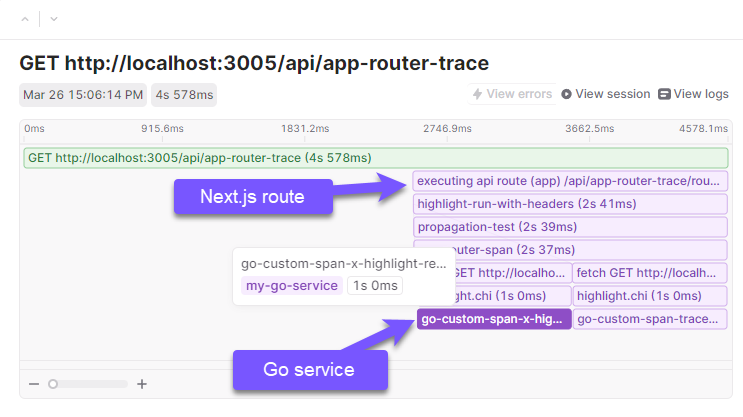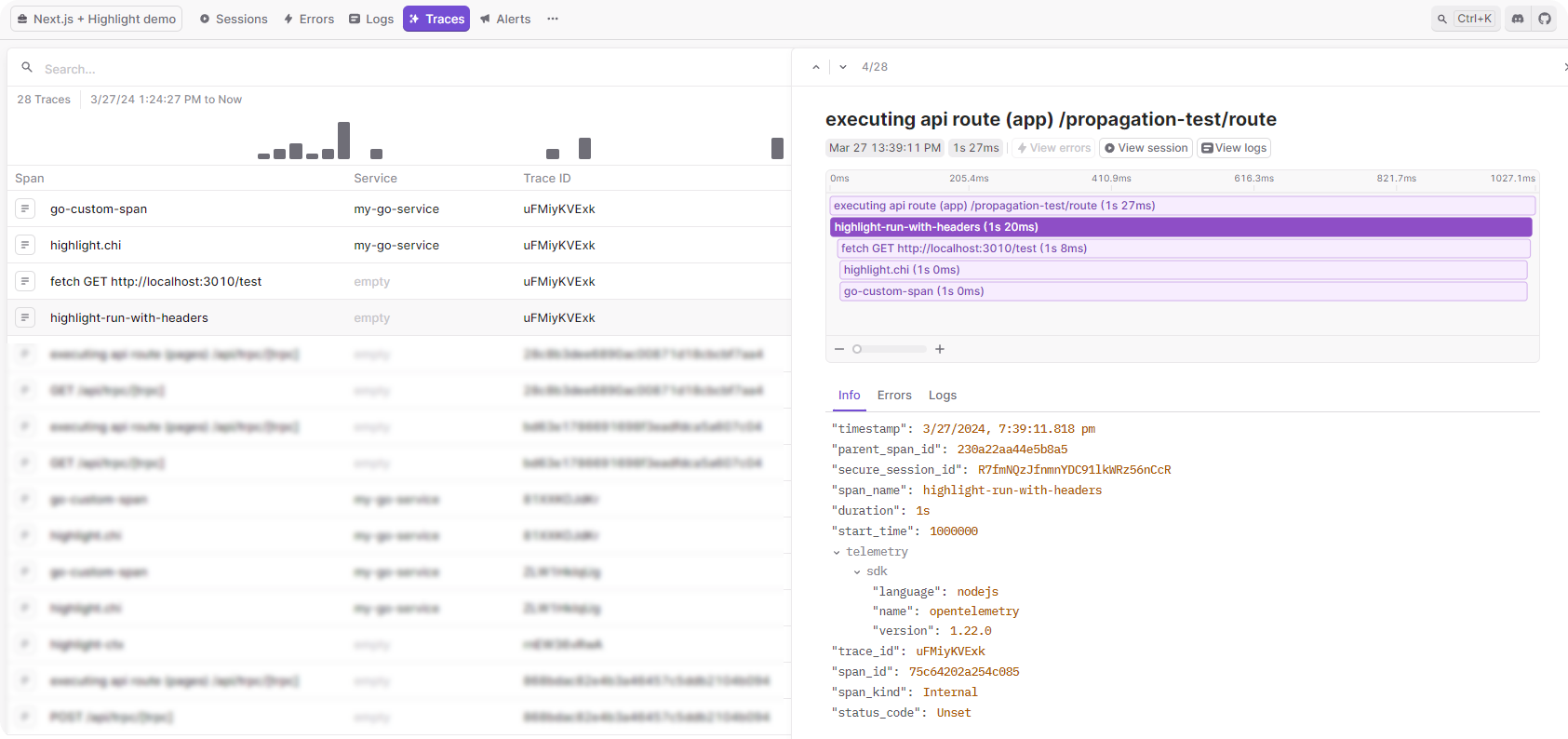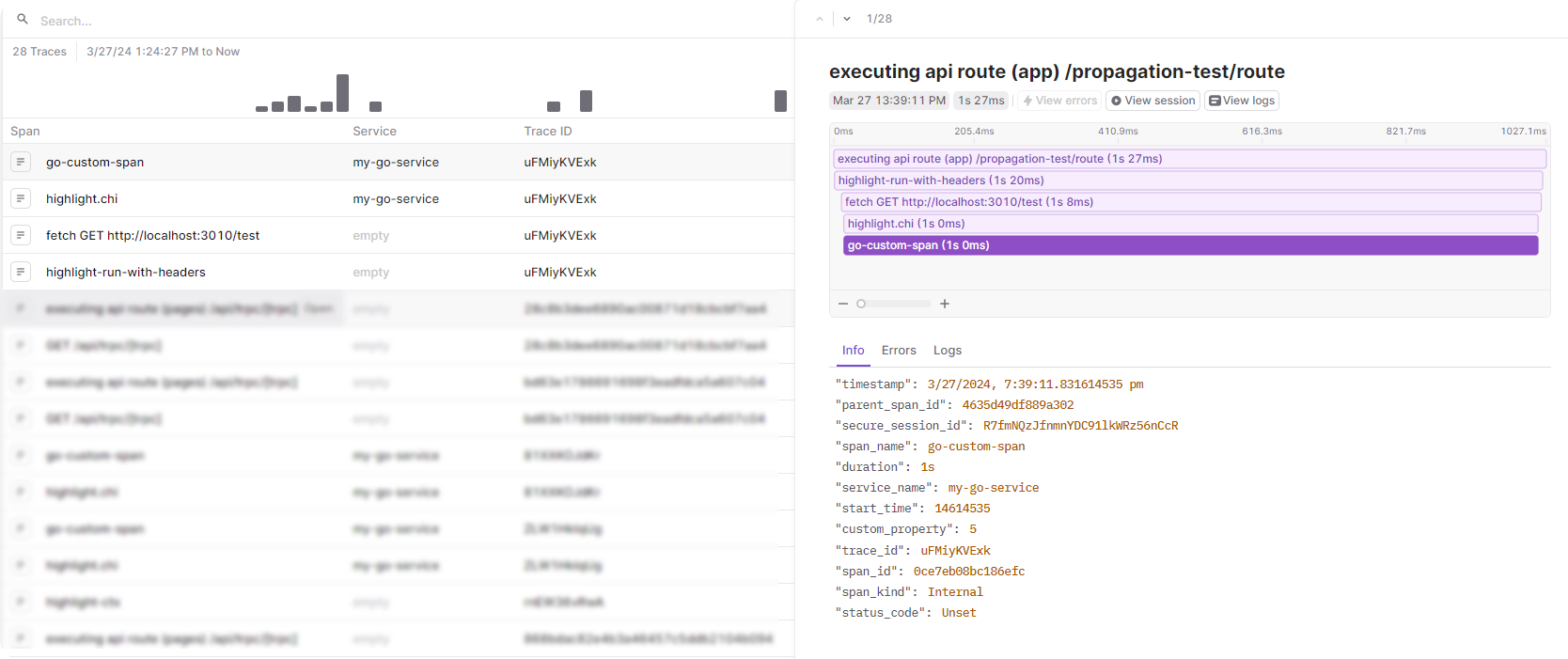Distributed Tracing
Distributed tracing is crucial for debugging and improving system performance. Instead of looking at the performance of each service in isolation, distributed tracing links traces across services to show how a request flows through a system. For instance, a trace might start in a React web client, pass through a Next.js API, and continue across subsequent HTTP calls, keeping all activities under one umbrella. This not only simplifies tracking but also provides a clear, consolidated view of how different parts of your application interact.

Approach
In this post, we’ll go over a practical example of how tracing across multiple services work in the context of a modern NextJS application.
Here’s the exact github repo we’ll be pulling the example from:
GitHub: Distributed Tracing Example
We will demonstrate how to use Highlight to connect a NextJS application with an external service by passing HTTP headers in the following steps:
- Next Client: The web client initiates an HTTP
Fetchrequest, passing thex-highlight-requestheader which contains a generatedsessionIdandrequestId. - Next Server: A Next.js API function receives that request, associates the
sessionIdandrequestIdto it's local trace, then passes thex-highlight-requestheader to a third service, this time written in Golang. - Go Server: The Golang service receives the
x-highlight-requestheader and associates it to the local trace.
Instrumenting the Next.js web client
Client-side integration is as easy as injecting <HighlightInit /> into your web app.
- Inject
<HighlightInit />once, preferably in alayout.tsxfile or_app.tsxfile. <HighlightInit />accepts props that correspond to the JavaScript SDK's options arguments.- Explore Highlight's wide range of configuration options, including
- Canvas and WebGL support,
- user identification,
- and privacy and redaction.
// app/layout.tsx import { CONSTANTS } from "../constants"; import { HighlightInit } from "@highlight-run/next/client"; export default function RootLayout({ children, }: { children: React.ReactNode; }) { return ( <> <HighlightInit // excludedHostnames={['localhost']} projectId={CONSTANTS.ENV.HIGHLIGHT.PROJECT_ID} serviceName="my-nextjs-frontend" tracingOrigins networkRecording={{ enabled: true, recordHeadersAndBody: true, }} debug /> <html lang="en"> <body>{children}</body> </html> </> ); }
Calling the Next.js API function
We'll use the browser's Fetch API to call a Next.js API function. Highlight monkey patches window.fetch and adds the x-highlight-request header automatically, so use Fetch as you normally would.
See the full list of monkey patches in our docs.
<button onClick={async () => { await fetch("/propagation-test"); }} >Trigger propagation</button>
Wrapping Next.js API functions
First, create a wrapper function. The Next.js SDK wrapper functions capture incoming headers and wrap the handler in a custom span named highlight-run-with-headers.
In this case, we're using the App Router, so we'll follow the Next.js App Router Guide.
// utils/app-router-highlight.config.ts: import { AppRouterHighlight } from "@highlight-run/next/server"; import { CONSTANTS } from "../../constants"; export const withAppRouterHighlight = AppRouterHighlight({ projectID: CONSTANTS.ENV.HIGHLIGHT.PROJECT_ID, });
Next, we wrap our GET handler function. Note that we wrap our handler function with withAppRouterHighlight, and we forward request.headers along with the next HTTP request.
The x-highlight-request header is only header that matters in this example.
// app/propagation-test/route.ts import { NextRequest } from "next/server"; import { withAppRouterHighlight } from "../_utils/app-router-highlight.config"; export const GET = withAppRouterHighlight(async (request: NextRequest) => { console.info("Here: app/propagation-test/route.ts"); const response = await fetch("http://localhost:3010/test", { method: "GET", headers: request.headers, // x-highlight-request is the critical header }); const data = await response.text(); return new Response(data); });
Configure our Golang service
Highlight supports multiple Go libraries. In this case we're using the Highlight chi SDK.
See a working example of Highlight chi implementation on GitHub.
First, we configure the highlight-go SDK.
import ( "github.com/highlight/highlight/sdk/highlight-go" ) func main() { // ... highlight.SetProjectID("<YOUR_PROJECT_ID>") highlight.Start( highlight.WithServiceName("my-app"), highlight.WithServiceVersion("git-sha"), ) defer highlight.Stop() // ... }
Next we add the Chi middleware.
import ( highlightChi "github.com/highlight/highlight/sdk/highlight-go/middleware/chi" ) func main() { // ... r := chi.NewRouter() r.Use(highlightChi.Middleware) // ... }
The highlightChi.Middleware function will automatically associate the current request with the incoming x-highlight-request header.
W3C traceparent example code
We used the x-highlight-request header in this example, but we also tested OpenTelemetry's native JavaScript Propagation example using the W3C traceparent header.
Instead of passing x-highlight-request header, it is possible to pass a traceparent header across HTTP calls. It's a bit involved, but it works great. See the links below for example code:
- withPropagation: an example wrapper for Next.js
- GET route: Pass
request.headersalong as before. - Golang example: Associate the incoming
traceparentheader with a local trace.
Result
All three services, the web client, the Next.js API function, and the Golang backend, now feed their data to the same Highlight project.
For the purposes of example, we can even visualize this data in our product (and open source application monitoring tool), Highlight!
This example shows four separate spans, all of which are nested under a single trace. And of course, these traces are accessible from Highlight's Session Replay tab, because the session was generated in the web client and propagated throughout the entire distributed "call stack".
highlight-run-with-headersis generated by theAppRouterHighlightwrapper function in Next.js.fetch GET https://localhost:3010/testis generated by the Next.jsFetchrequest.highlight.chiis created by Highlight's chi middleware.go-custom-spanis a custom span that we used in our example code for demonstration purposes. It wraps a call totime.Sleep(1 * time.Second)to mimic slow code execution.
 highlight-run-with-headers
highlight-run-with-headers
 go-custom-span
go-custom-span
Other articles you may like
Apr 18, 2023 • 6 min. read
